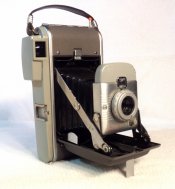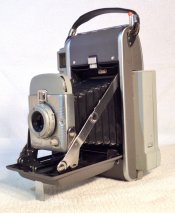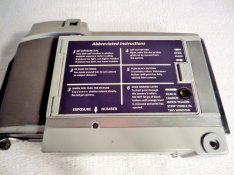Hunter_Compton
Member
This is a project that I have been mulling around in my head awhile. I have always found it fun to tinker with the older Polaroid roll film cameras, my first conversion being a Model 150 converted to pack film and later a Model 95B converted to the same. However, with Fuji having discontinued FP-3000B and then FP-100C a few years back, making instant pack film extinct it was time to play with an alternative.
The Polaroid Model 80 Highlander was an attempt by Polaroid to take their instant roll film technology and mate it with a product that was both less expensive and more compact than the larger 40-series cameras. I have always thought that these cameras are undervalued. Having owned a couple, they feel really good in the hand, not overly heavy like the 40-series cameras and have nice 3-element glass lenses. That said, they take 30-series Land picture rolls which were discontinued in the 1970s making their doorstop status understandable. The camera I used for this conversion cost me all of $4.00. I have seen some other conversions of the Highlander, but all involved converting to use 120 roll film, and to me that loses the instant nature of the camera, hence a desire to preserve that functionality.
The Fuji Instax mini format seemed like the best option for this conversion, there are not many options left for instant film in today’s market and the image size of the Instax mini format was the closest to that of 30-series roll films without needing a mirror in the optical path like the Impossible/Polaroid Originals offerings. The back I used for this conversion was hacked off a broken Lomo Instant camera with a lot of bodywork necessary to get the film plane as close as possible to that in the Highlander. I have never been particularly fond of the Lomography trend, but to each their own, this camera was however, the cheapest way to get an instant back that took Instax mini film without spending an arm and a leg.
Aside from removing the lens and shutter assembly from the Lomo camera and modifying the body, I also had to make some changes to the film ejection mechanism. The Lomo instant camera had the film pick arm coupled to the rollers all powered by an electric motor. A microcontroller determined when to stop the motor so that the film would be fully ejected but not begin ejecting another film sheet. However, I decided to scrap the circuit board as it both interfered with getting the film plane as close to the original as possible and was unnecessary since I did not use the shutter and lens assembly from the original Lomo camera. I also had to remove the gear train that coupled the pick arm to the motor as it was routed in front of the film plane and hit the body when moving. Instead, I retained the motor coupling to the rollers but put a momentary contact switch in place. The film pick arm is now coupled to a lever which protrudes from the top of the camera so that the manual of arms is to take the picture, hold down the black button and push the pick arm button until the photo has ejected. The photo ejects from a slot visible after the cutter bar is lifted. The roller motor is powered by 4: AAA batteries in a holder contained in the Highlander body where the positive roll would have originally gone.
The most disconcerting aspect of this conversion was adjusting the focal length of the lens. The nature of the Instax back I used was that no matter how close you sliced it the material thickness of the back and the Instax film pack itself meant that there would be a 1/8” gap between the old and new film plane no matter what was done. There is no way to move the lens board on the self-erecting design of the Model 80 camera unlike its larger brethren, fortunately there is enough adjustment in the front lens element to make up for the offset. Even shooting at fairly large apertures, I did not notice any focusing issues, although adjusting the effective focal length of the lens may have changed the curve of distance markings on the lens ring thus they should be treated as an approximation. I collimated the lens with the marked distance settings at 8 feet expecting most shots taken to be at close range given the small image size.
The Instax back is offset slightly in the film plane so that the pick arm and roller gears clear the side of the film plane body, this is possible since the Instax mini format is smaller than the original image size and I have not noticed any particular defects from doing so. In order to accommodate the offset and new image size I put a mask over the front viewfinder glass for accurate framing. I also glued a piece of 2-stop ND filter over the rear lens ring to compensate for Instax film being 800 ISO, with the ND filter in place the film behaves as if it were ASA 200.
Finally, I created an instructional card which mimics that found on the roll film cameras to occupy the space that originally had leatherette on the film door on the Lomo back. (Not sure why this shows as purple in the photo, probably something to do with the lighting setup I am using, looks dark grey in reality.)






Here is a test image from this camera after the conversion:

The Polaroid Model 80 Highlander was an attempt by Polaroid to take their instant roll film technology and mate it with a product that was both less expensive and more compact than the larger 40-series cameras. I have always thought that these cameras are undervalued. Having owned a couple, they feel really good in the hand, not overly heavy like the 40-series cameras and have nice 3-element glass lenses. That said, they take 30-series Land picture rolls which were discontinued in the 1970s making their doorstop status understandable. The camera I used for this conversion cost me all of $4.00. I have seen some other conversions of the Highlander, but all involved converting to use 120 roll film, and to me that loses the instant nature of the camera, hence a desire to preserve that functionality.
The Fuji Instax mini format seemed like the best option for this conversion, there are not many options left for instant film in today’s market and the image size of the Instax mini format was the closest to that of 30-series roll films without needing a mirror in the optical path like the Impossible/Polaroid Originals offerings. The back I used for this conversion was hacked off a broken Lomo Instant camera with a lot of bodywork necessary to get the film plane as close as possible to that in the Highlander. I have never been particularly fond of the Lomography trend, but to each their own, this camera was however, the cheapest way to get an instant back that took Instax mini film without spending an arm and a leg.
Aside from removing the lens and shutter assembly from the Lomo camera and modifying the body, I also had to make some changes to the film ejection mechanism. The Lomo instant camera had the film pick arm coupled to the rollers all powered by an electric motor. A microcontroller determined when to stop the motor so that the film would be fully ejected but not begin ejecting another film sheet. However, I decided to scrap the circuit board as it both interfered with getting the film plane as close to the original as possible and was unnecessary since I did not use the shutter and lens assembly from the original Lomo camera. I also had to remove the gear train that coupled the pick arm to the motor as it was routed in front of the film plane and hit the body when moving. Instead, I retained the motor coupling to the rollers but put a momentary contact switch in place. The film pick arm is now coupled to a lever which protrudes from the top of the camera so that the manual of arms is to take the picture, hold down the black button and push the pick arm button until the photo has ejected. The photo ejects from a slot visible after the cutter bar is lifted. The roller motor is powered by 4: AAA batteries in a holder contained in the Highlander body where the positive roll would have originally gone.
The most disconcerting aspect of this conversion was adjusting the focal length of the lens. The nature of the Instax back I used was that no matter how close you sliced it the material thickness of the back and the Instax film pack itself meant that there would be a 1/8” gap between the old and new film plane no matter what was done. There is no way to move the lens board on the self-erecting design of the Model 80 camera unlike its larger brethren, fortunately there is enough adjustment in the front lens element to make up for the offset. Even shooting at fairly large apertures, I did not notice any focusing issues, although adjusting the effective focal length of the lens may have changed the curve of distance markings on the lens ring thus they should be treated as an approximation. I collimated the lens with the marked distance settings at 8 feet expecting most shots taken to be at close range given the small image size.
The Instax back is offset slightly in the film plane so that the pick arm and roller gears clear the side of the film plane body, this is possible since the Instax mini format is smaller than the original image size and I have not noticed any particular defects from doing so. In order to accommodate the offset and new image size I put a mask over the front viewfinder glass for accurate framing. I also glued a piece of 2-stop ND filter over the rear lens ring to compensate for Instax film being 800 ISO, with the ND filter in place the film behaves as if it were ASA 200.
Finally, I created an instructional card which mimics that found on the roll film cameras to occupy the space that originally had leatherette on the film door on the Lomo back. (Not sure why this shows as purple in the photo, probably something to do with the lighting setup I am using, looks dark grey in reality.)






Here is a test image from this camera after the conversion:











